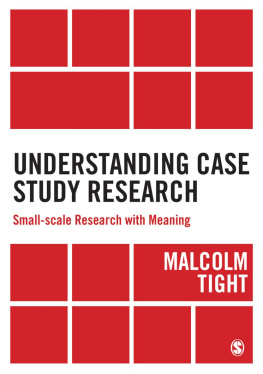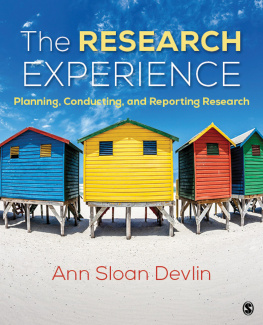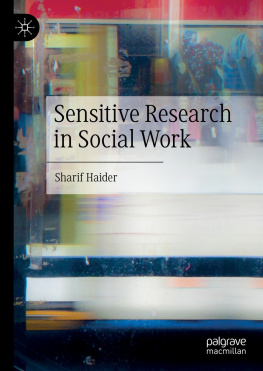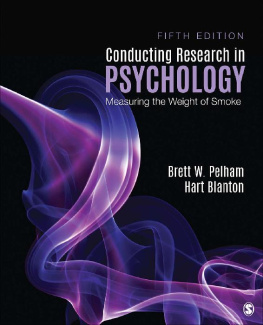Devlin - The Research Experience: Planning, Conducting, and Reporting Research
Here you can read online Devlin - The Research Experience: Planning, Conducting, and Reporting Research full text of the book (entire story) in english for free. Download pdf and epub, get meaning, cover and reviews about this ebook. City: Los Angeles, year: 2017, publisher: SAGE Publications, genre: Art. Description of the work, (preface) as well as reviews are available. Best literature library LitArk.com created for fans of good reading and offers a wide selection of genres:
Romance novel
Science fiction
Adventure
Detective
Science
History
Home and family
Prose
Art
Politics
Computer
Non-fiction
Religion
Business
Children
Humor
Choose a favorite category and find really read worthwhile books. Enjoy immersion in the world of imagination, feel the emotions of the characters or learn something new for yourself, make an fascinating discovery.

The Research Experience: Planning, Conducting, and Reporting Research: summary, description and annotation
We offer to read an annotation, description, summary or preface (depends on what the author of the book "The Research Experience: Planning, Conducting, and Reporting Research" wrote himself). If you haven't found the necessary information about the book — write in the comments, we will try to find it.
About the Author
Introduction
Chapter 1 Research, Biases in Thinking, and the Role of Theories
Why Research Matters
The Research Process: Humans Make Predictions
Heuristics and the Work of Kahneman and Tversky
Other Problems in Thinking
Doing Science as Tradition and Innovation
Research and the Value of Common Sense
Flexibility in Thinking
Theories: What They Are and Why They Matter
Making a Connection Between a Theory and a Good Research Question
Summary
Chapter 2 Generating and Shaping Ideas: Tradition and Innovation
Overview
Ideas: Information Services, aka The Library
Ideas: Searching Effectively in the Library
Electronic Resources and Keywords
Keywords: The Key to Success
PsycINFO
Other Databases and Indexes in the Social Sciences
The Web and Peer Review
Particular Kinds of Articles
How Journals Differ: Issues Related to Quality
Open Access and Predatory Publishers
Publication Practices of Journals
Journal Articles Versus Book Chapters
Physically Obtaining an Article: A Closer Look at Databases
Summary of the Article Locator Search Process
Interlibrary Loan (ILL) Systems and World Catalog (WorldCat)
What to Do With Your Articles (Read More Than the Abstract!)
The Introduction
The Method Section
The Results Section
The Discussion Section: Conflicts and Gaps
Keeping Track: ILL, Mendeley, and RefWorks
Reasonable Questions and the Problem of Third Variables: Closing the Research Gap
Time Pressure and Timelines
Academic Fraud
Summary
Chapter 3 Research Design Approaches and Issues: An Overview
Overview
Research Quality Affects Research Answers
What Research Can Tell You: The Continuum of Certainty
Correlation Versus Causation
Why Conduct Correlational Research?
The Language of Correlation and Causation
Correlational Research Approaches: Correlational and Quasi-experimental
Hallmarks of True Experimental Approaches
Differentiation of Independent and Dependent Variables
Reframing a Research Idea
Type I Versus Type II Error
Type II Errors: Sample Size, Power, and Effect Size
Internal Validity
Behavior of the Experimenter and Demand Characteristics
Behavior of the Participant: Role Attitude
Single- and Double-Blind Approaches to Research
Cover Stories
Pilot Tests and Manipulation Checks
Summary of Additional Threats to Internal Validity
External Validity and Ecological Validity
Where Research Takes Place
Where Qualitative Research Takes Place
Summary
Chapter 4 Ethics and the Institutional Review Board (IRB) Process
Overview
What Is the IRB, and Why Does It Exist?
History of Ethical Oversight
The APA Code of Ethics
What Is Research? What Are Human Subjects?
IRB Membership and Duties
Levels of IRB Review
Components of the IRB Proposal
Informed Consent
Debriefing
Children as a Vulnerable Population: Implications for Research
Research With Children: Secondary Data Analysis
Deception and Its Alternatives
Ethics and Student Participation in Research: Alternatives to the Subject Pool
Offering Incentives in Research: Are Incentives Coercive?
Preparing an IRB Proposal
The IRB Training Modules
Summary
Chapter 5 Measures and Survey Research Tools
Overview
The Concept of Measurement: Ideal Versus Real
The Purpose of Measures
Measurement Scale Types
Sensitivity of a Scale and Anchor Values
The Process of Identifying Measures: The Literature
Databases of Tests (PsycTESTS and HaPI)
Books of Measures
Department Resources and Professors
Catalogs of Measures and Fees Charged
Qualities of Measures: Reliability and Validity
The Importance of Computing Your Own Cronbachs Alpha
Qualities of Measures: Validity
Length and Difficulty of Measures
Instructions for Scoring
Names of Measures and Social Desirability Concerns
Qualifications for Use
Developing Your Own Instrument
Scale Types and Flexibility in Answering Research Questions
The Order of Questions in a Survey
Online Survey Software Tools
Features of Online Survey Software Programs
Program Features
Google Docs Forms
Downloading Online Surveys into SPSS
Survey Appearance
Summary
Chapter 6 Correlational and Qualitative Research
Overview
Correlational Research: General Characteristics
Questions Posed About the Sample
Drawbacks to Correlational Approaches
Correlational Design: Quasi-experimental Design (i.e., Questions About Groups)
Statistics Used in Correlational Designs
Qualitative Research
Qualitative Research and the Concept of Reflexivity
Acceptance of Qualitative Methodology in the Social and Behavioral Sciences
Qualitative Approaches to Research
How to Capture Behavior: Behavioral Categories
How Often and How Long to Observe
Calculation of Inter-rater Reliability (IRR)
Acceptable Values for Inter-rater Agreement
Participant and Nonparticipant Observation and Overt/Covert Observation
Ethnography: Extended Observation
Issues in Ethnography: Gaining Access
Initial Ethnographic Tours
Preserving Information
Grounded Theory
Phenomenology
Focus Groups
Interviews: Degrees of Structure
Recording or Not
Case Studies and Case Histories
Where Qualitative Meets Quantitative: Content Analysis
Summary of Steps in a Content Analysis
Computer-Assisted Qualitative Data Analysis Software (CAQDAS)
Qualitative Research and the Emotional Self: A Final Consideration
Summary
Chapter 7 Experimental Approaches: Between Subjects Designs
Overview
Between Subjects Designs: What Are They?
Characteristics of Between Subjects Designs: Advantages and Disadvantages
Sensitivity of IV
More on Power, Sample Size, and Power Calculations
Number of IVs and Interaction Effects
Evaluating an Interaction by Hand
Common Types of Between Subjects Design
Matched Groups Design
Multiple Comparisons
Handling Error Variance
Summary of Between Subjects Design Considerations
Finding and Creating IVs (Scenarios; Visual Images; Movie Clips; Auditory Clips)
Existing Literature: Method Section
Visual Images: Manipulating an Image
Multiple Dependent Variables (DVs) in a Research Design
Factor Analysis: An Overview
Summary
Chapter 8 Within, Mixed, Pre-Post Experimental, and Specialized Correlational Designs
Overview
Characteristics of Within Subjects Design: Advantages and Disadvantages
Types of Research Questions More Commonly Asked in Within Subjects Designs
Counterbalancing
Simple and Complex Within Subjects Designs
Adding Complexity to Within Subjects Designs
Mixed Designs
Pre-Post Designs: Characteristics
Types of Pre-Post Designs
Specialized Correlational Designs
Time-Series and Interrupted Time-Series Design
Strengths and Weaknesses of This Approach
When Is This Approach Used?
Real-World Challenges: Postoccupancy Evaluation (POE)
Longitudinal and Cross-Sectional Designs
Advantages and Disadvantages of the Longitudinal Approach
Advantages and Disadvantages of the Cross-Sectional Approach
Cohort-Sequential Design
Advantages of Using Multiple Methods
Summary
Chapter 9 Recruiting Participants
Overview
Who Participates in Research: An Overview
The Subject Pool: The Workhorse of Social Science Research
The Drawbacks to Subject Pools: Concerns About Internal Validity
Limits on the Number of Participants Available From Unpaid Subject Pools
Keeping Track of Participants: Online Participant Management Systems
Practical Issues in Communicating About Recruiting
Research on Sensitive Topics and the Role of the IRB
Recruiting Off Campus
Using Your Personal Connections
Using Your Instituti
Devlin: author's other books
Who wrote The Research Experience: Planning, Conducting, and Reporting Research? Find out the surname, the name of the author of the book and a list of all author's works by series.















